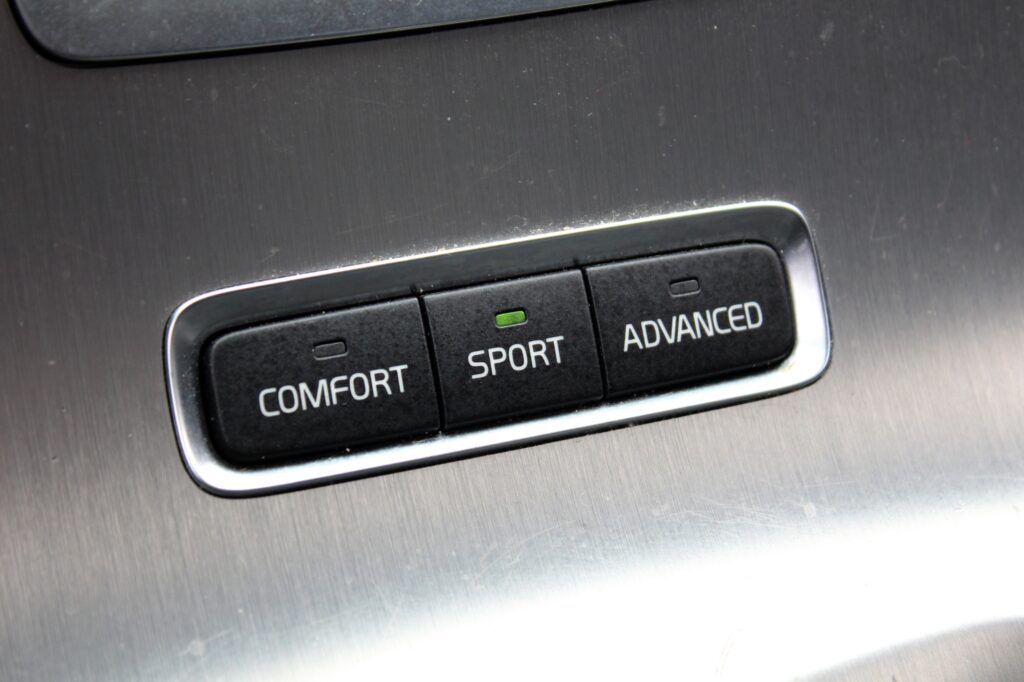The suspension system ensures that you have a smooth driving experience even when there are dozens of bumps and dips on the road.
The system stabilizes the vehicle and maintains the tires’ road traction for steering stability and optimized handling.
While conventional suspension systems are already good at optimizing ride comfort and handling, many automakers sought to innovate suspension performance by introducing adaptive suspension systems.
What Is an Adaptive Variable Suspension System?

An adaptive suspension system is a type of setup that lets drivers fine-tune their suspensions, depending on certain road conditions.
In most vehicles with adaptive suspension systems, drivers can choose from presets by pressing buttons to modify suspension performance.
For example, vehicles with a “Comfort” setting can adjust the suspension to be more compliant and absorb potholes better than other presets. Meanwhile, switching to “Sport” adjusts wheel movement to maintain tire traction.
How Do Adaptive Suspension Systems Work?
There isn’t one way to explain how adaptive suspension systems work. “Adaptive” is an umbrella term used to describe suspension systems that can be modified to optimize their performance.
The operation of adaptive suspension systems varies according to their type, which we’ll be tackling later on.
Some systems use electronically adjustable valves within the suspension dampers, while others use electromagnetic coils acting on a special damper fluid.
Meanwhile, luxury vehicles with an adaptive suspension system will usually adjust to road conditions automatically by monitoring wheel speed and using cameras.
Types of Adaptive Suspension Systems
An adaptive suspension system comes in many forms, including magnetorheological, valve-actuated, air suspension, electronic, and manually adjustable.
Magnetorheological
Certain models from General Motors and Volkswagen have a magnetorheological adaptive suspension system.
This type uses a monotube design filled with magnetorheological fluid, which is a kind of synthetic oil infused with iron particles. These iron particles align when subjected to a magnetic field.
The activity in a magnetorheological suspension system doesn’t necessarily affect the viscosity of the fluid.
However, the alignment of the particles is enough to bring the fluid to a solid-like state so that the damper’s piston won’t move as much. As a result, body roll is significantly reduced.
Also, the strength of the magnetic field will determine how “solid” the fluid should be. The vehicle’s software then uses this information to adjust the damper.
Valve-Actuated
A valve-actuated suspension system relies on valves to control the fluid’s flow rate through the piston. In this setup, a restricted flow results in a firmer stroke from the damper’s piston.
In some valve-actuated suspension systems, accelerometers and ride height sensors are used to make adjustments accordingly.
Adaptive Air Suspension
An adaptive air suspension system uses airbags or air springs instead of coil springs. These springs are usually made from a rubber and polyurethane composite and filled with air via a compressor.
The more air that goes in these springs, the higher the ride height and the softer the suspension.
Adaptive air suspension systems can either be open or closed.
In an open air suspension system, you’ll usually hear a hissing sound when decreasing ride height because of the rubber membrane releasing air into the atmosphere upon depressurizing.
On the other hand, a closed air suspension system returns air to the reservoir when depressurizing. This helps the system to make quick changes in ride height.
Electronic
Many adaptive damping suspension systems are electronically controlled. Electronically controlled systems rely on motors and electromagnets to adjust the opening of the damper flow valve.
Once the damper flow valve is opened, oil can flow more freely, resulting in greater compression and a softer ride. Meanwhile, closing the damper flow valve does the opposite.
Manually Adjustable
Although not as advanced as other suspension systems, a manually adjustable suspension setup still falls under the “adaptive” category.
In a manually adjustable suspension setup, the driver needs to house the vehicle on a jack and manually adjust the opening of the damper flow valve. In most cases, rotating a knob on each shock absorber activates a specific setting.
Adaptive Suspension Systems: Advantages and Disadvantages
Adjustability is arguably the most notable advantage of an adaptive suspension system over a conventional one.
With an adaptive suspension setup, drivers can tailor their vehicle’s specifications to improve ride comfort or cornering when needed.
With an adaptive suspension system, you can customize your vehicle in more ways than one to accommodate various driving conditions.
On the downside, this setup doesn’t necessarily add energy to the suspension system. Instead, it can only change the viscous damping coefficient of the shock absorber.
Also, most adaptive suspension systems have a slow time response and limited damping coefficient values.
Because of these factors, many adaptive suspension systems usually come with a few riding modes that correspond to different damping coefficients.
Is an Adaptive Suspension System Worth It?
Drivers who are meticulous about handling, cornering, and overall ride comfort will enjoy the benefits of owning a vehicle with an adaptive suspension system.
However, you can expect to shell out more money when buying a vehicle with this feature, as it is usually found in luxury vehicles and other performance cars. You might also find this feature installed in more expensive trim levels.
There are a handful of vehicles that come with adaptive suspension systems, but they tend to go by different names.
For instance, BMW calls their adaptive suspension feature “Adaptive M Suspension,” while Ford uses the term “Continuously Controlled Damping.” Mercedes, on the other hand, uses the term “Active Body Control.”
Any information provided on this Website is for informational purposes only and is not intended to replace consultation with a professional mechanic. The accuracy and timeliness of the information may change from the time of publication.






















